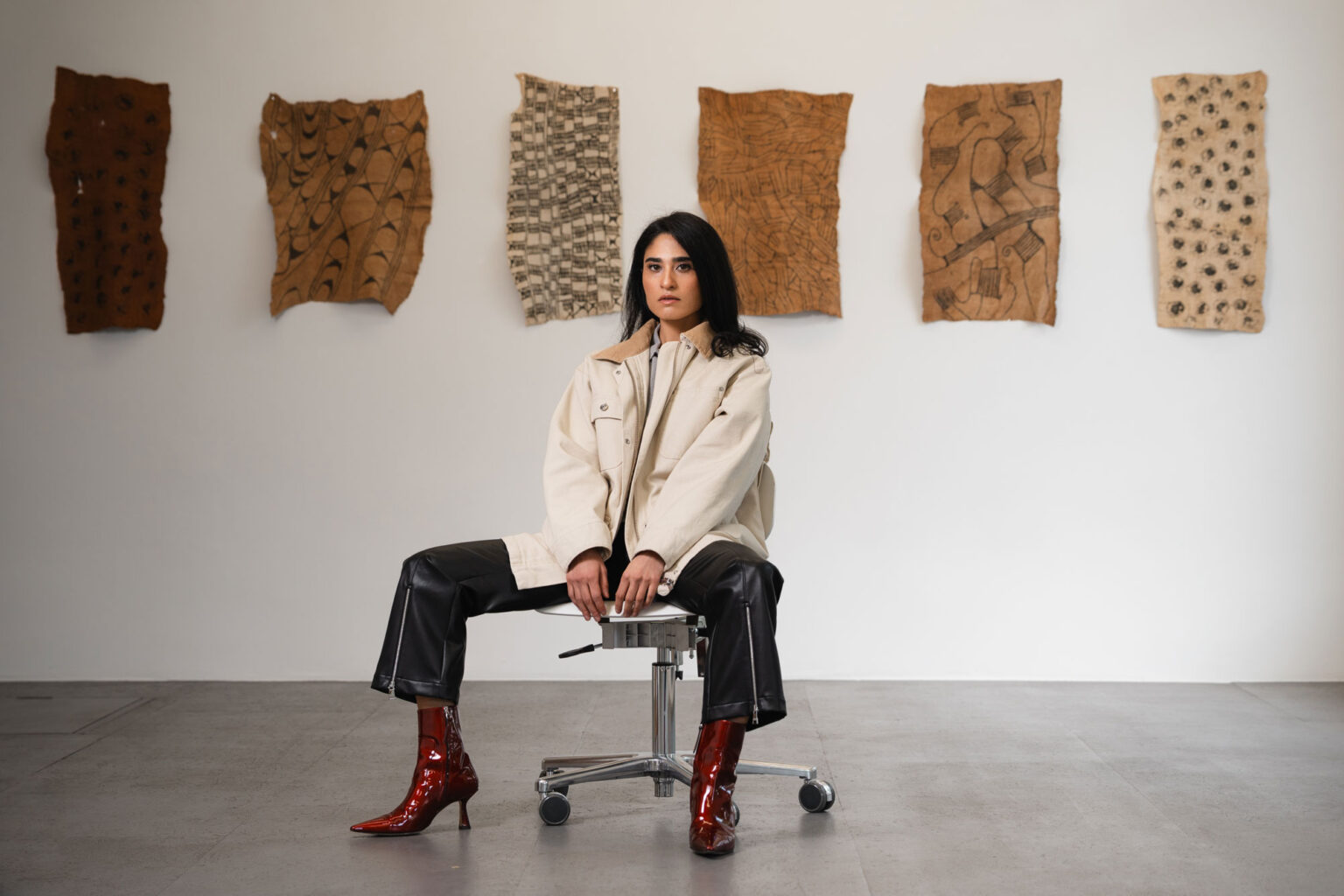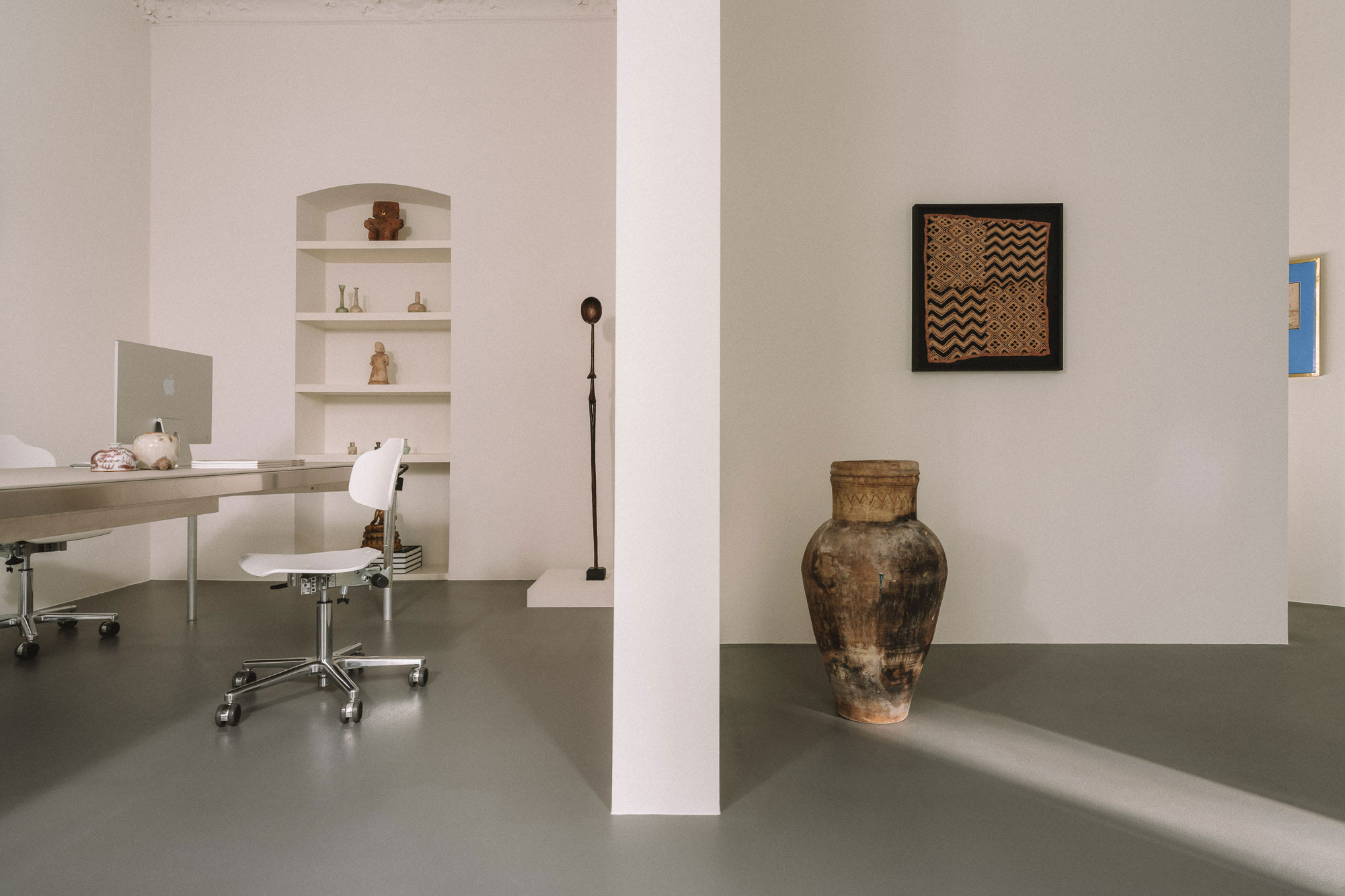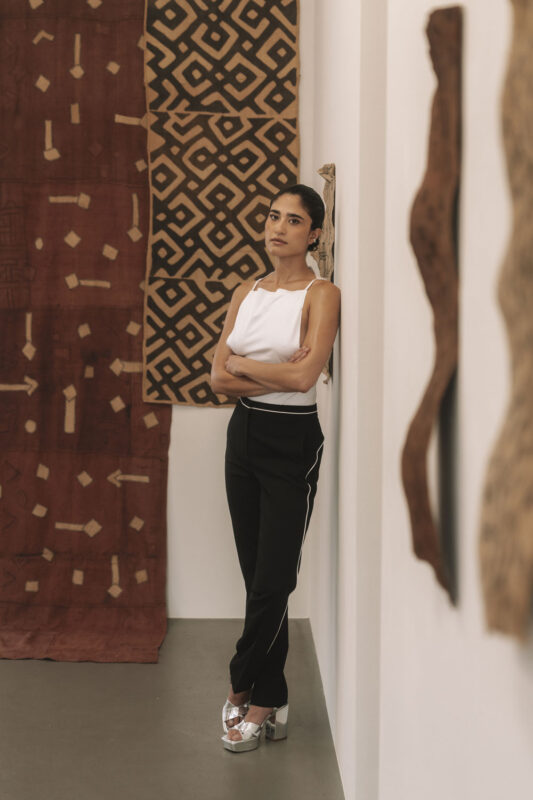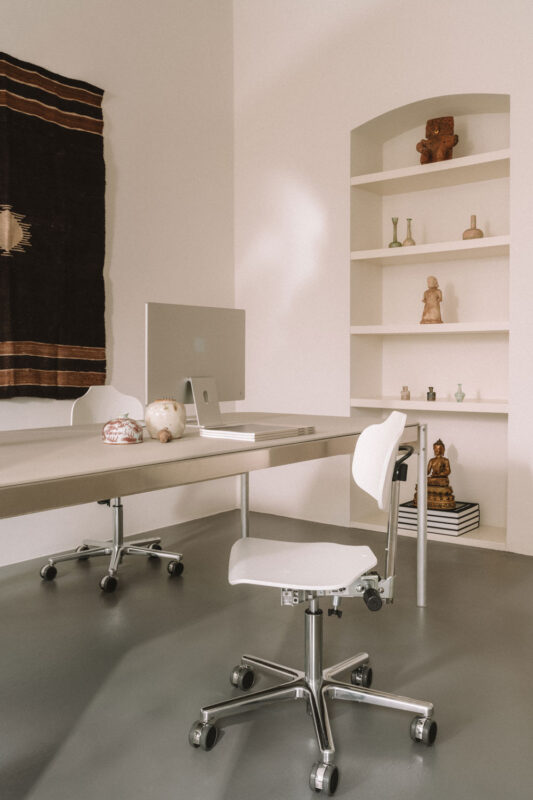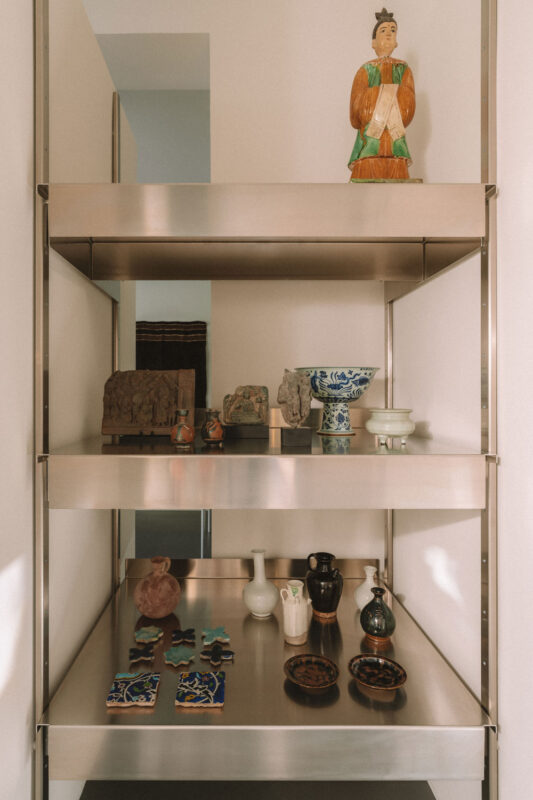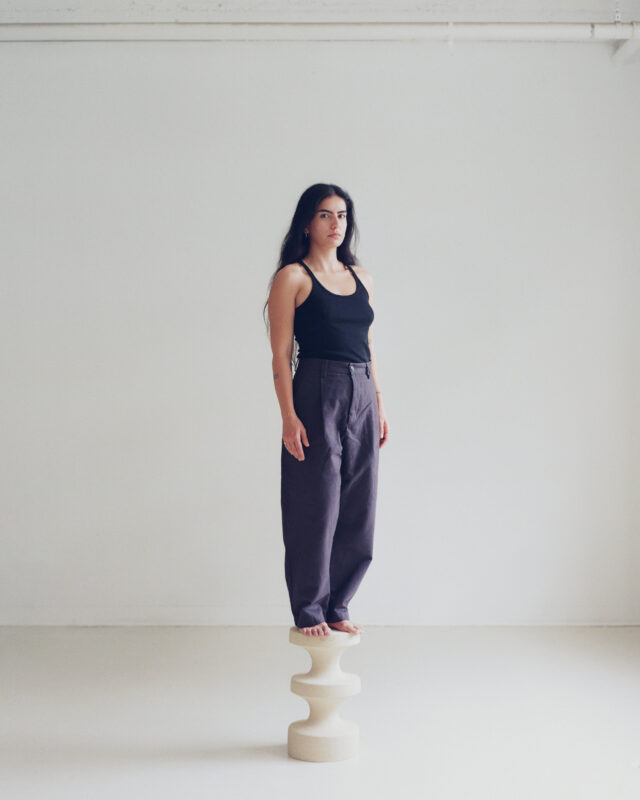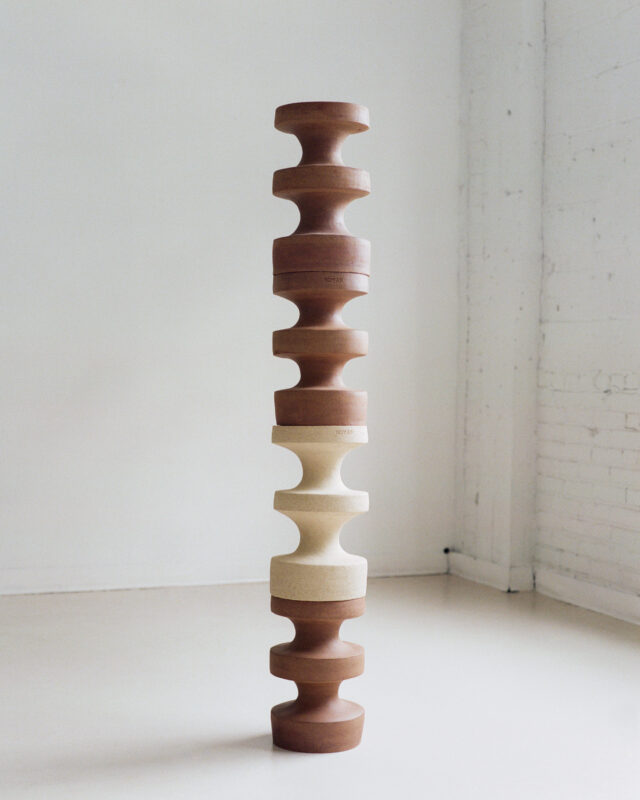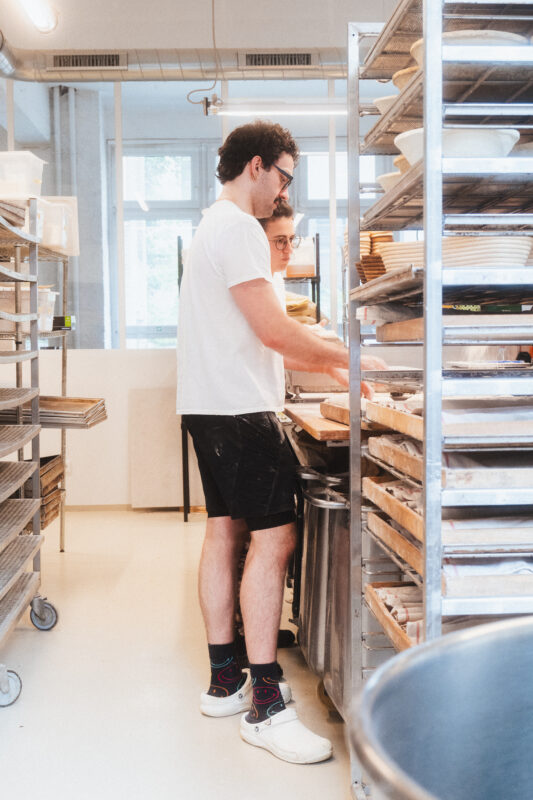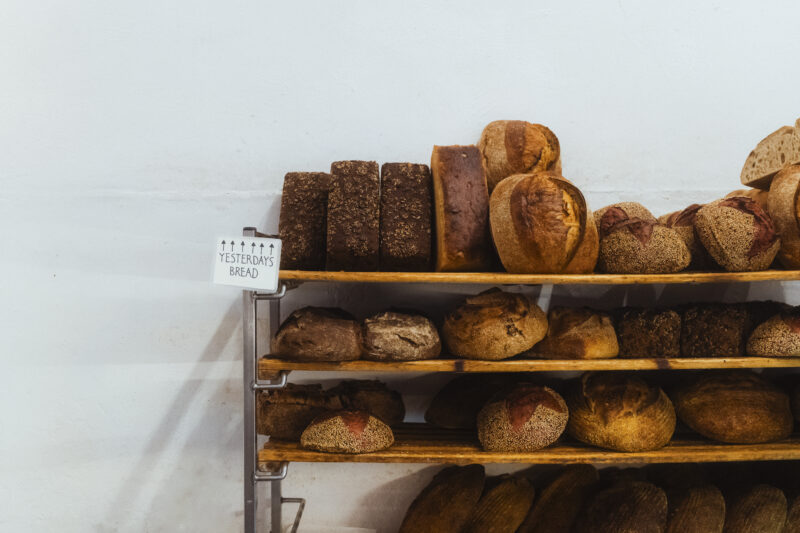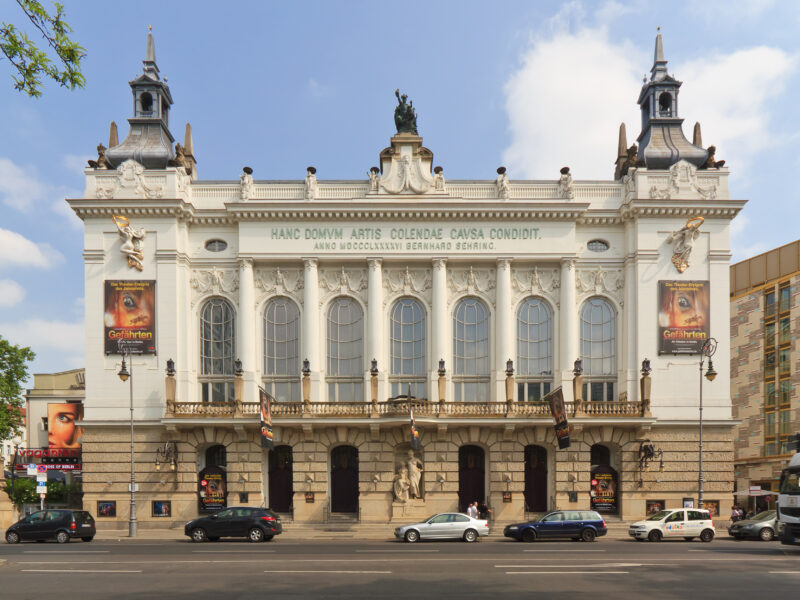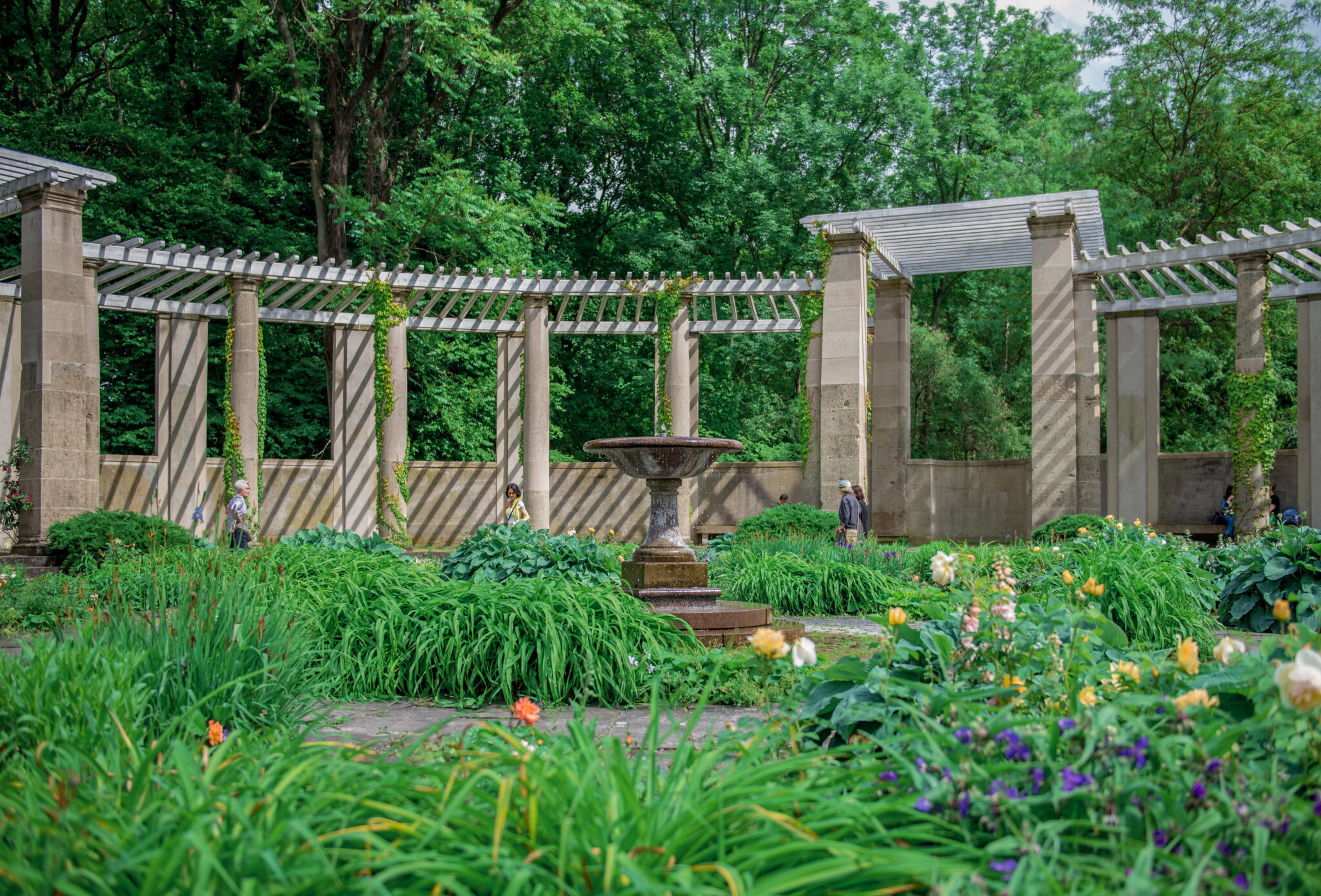Persian amphorae as vessels of cultural memory: In her latest project, “Soft Power”, Anahita Sadighi presents historical objects, floral interventions, glass installations and contemporary soundscapes as a multi-layered dialogue centring on the “Woman, Life, Freedom” movement in Iran. By means of art, music and dialogue, the works reflect transnational feminist cultures of remembrance.
Through her work, Sadighi sees multidisciplinary art not as a concept, but as a way of life. By crossing boundaries—between genres, disciplines and cultural contexts—new forms of expression and understanding emerge. This philosophy has also shaped her current project. ‘Soft Power’ was presented as the official Featured Special Project of Berlin Art Week 2025.
© Clemens Poloczek
Which place do you currently call home and where do you work on your projects?
My home is Berlin, where I live and work. At the same time, I also feel a deep sense of belonging to Iran. A connection that is part of me, no matter where I am. For me, home is not just a physical place, but where I feel grounded. Most of the time, I work in my gallery in Charlottenburg or from home. Depending on the project, I also spend time on site.
Just recently, we presented Soft Power, a large-scale installation at Haus der Visionäre as part of Berlin Art Week.
Haus der Visionäre is a new site-responsive venue and arts space that reflects where Berlin’s cultural scene is headed. Combining dance, community and an unmatched sound system, it is a place where music and cultural experimentation come together beyond exhibitions or texts.
In addition, our interdisciplinary format The Loft presents takes place there and at the adjacent Sonnenraum. So while the gallery remains my base, my projects often extend into other spaces.
Where is your studio located & how does it look?
My gallery and studio are located in a beautiful late 19th-century corner building at Schlüterstraße and Pestalozzistraße in Charlottenburg. It is a bright, light-filled gallery space with large windows. The renovation was realised by my close friend Pierre Jorge Gonzalez of Gonzalez Haase AAS.
I believe that art and architecture have always belonged together—that goes as much for ancient epochs as it does today. Working with Pierre Jorge on the interior was a great pleasure. I was impressed by his ability to merge historical substance with a contemporary language—an approach that reflects the dialogue I aim for in my own work. He didn’t just reconfigure the rooms, he also designed the entire interior, from custom aluminium shelving and window benches to a large office table created in collaboration with freistil Rolf Benz, which has become a centrepiece in the space. His approach is to reflect the personality of the people behind a space and here new stories will be created and told.
The original substance of the space, with its stucco and unusual L-shaped layout, was preserved and set in dialogue with a reduced, modern design vocabulary. The atmosphere is minimalist yet warm, with a refined palette using Keim mineral paints, known for their natural and sustainable qualities. Outside, a lightbox by Dieter Detzner carries the Rumi quote ‘What you seek is seeking you’, the calligraphy realised together with Sin Seeni.
Charlottenburg has always been an important gallery district, shaped by antiquarian bookshops, old cinemas and cultural institutions. The West has been enjoying a revival for several years now and it’s far from over. Many visitors and Berliners alike are rediscovering Charlottenburg in a positive light and as a resident I am glad to contribute to this ongoing transformation.
© Clemens Poloczek
© Clemens Poloczek
© Clemens Poloczek
Are there any projects that are personally important to you—whether recently completed or currently in progress?
One project that is especially close to my heart at the moment is our exhibition Floating Worlds – Eloa Unique Lights & Japanese Woodblock Prints (13 September – 22 November 2025). It brings together masterpieces of Ukiyo-e with contemporary glass sculptures by Eloa unique lights.
The woodblock prints, created between the 17th and 19th centuries, capture urban life, landscapes, actors and intimate scenes with extraordinary sensitivity—embodying the very essence of ephemerality and beauty. What fascinates me is how these works not only shaped Japanese culture but also profoundly influenced the European avant-garde, inspiring artists such as Van Gogh, Monet and Matisse.
In dialogue, Eloa’s luminous glass objects like Pleiades and the newly unveiled Eridani expand this notion of the “floating world” into the present. They translate transience into sculptural forms of light, weaving historical depth with contemporary artistic inquiry. For me, Floating Worlds is a way of opening new perspectives on global art history—showing how past and present, diverse cultures and artistic approaches resonate with one another.
At the same time, another thread that runs through my work is the idea of Soft Power. It first emerged with my installation dedicated to the Woman, Life, Freedom movement at the beginning of the protests in September 2022. What began there has since grown into a guiding principle of my practice. The most recent manifestation of this idea was the large-scale installation presented as a Featured Special Project of Berlin Art Week 2025. I am drawn to the notion of Soft Power—the subtle cultural force that can transform perception and create bonds of understanding without coercion—and I seek to translate this into artistic form.
In times of political polarisation and global crises, this principle feels more urgent than ever. Soft Power is my response to these challenges: an invitation to foster mutual understanding, strengthen social cohesion and create spaces where people from different backgrounds, experiences and perspectives can meet on equal footing. It positions art and culture as tools for dialogue, empathy and collective action—and in doing so, contributes to a more open, resilient and future-oriented society.
© Roman März
Do you have a favorite place in your area where you like to relax and linger?
I find great peace in the Tiergarten, a true oasis in the middle of the city. Not far from there, the SO/ Berlin Das Stue offers a spa I sometimes visit to restore my energy. I also love the Grunewald, a beautiful forest only a short distance from Kurfürstendamm. And then there are the small, family-run cafés like Café 1900 at Savignyplatz, where I enjoy spending quiet hours.
© Leonhard Lenz, Teufelsberg listening station Berlin-Grunewald 2021-10-13 03, adjusted colours, CC0 1.0
Are there any urgent political issues or problems in your region?
Yes, in both Germany, where I live, and Iran, my country of origin, urgent political challenges define the present in very different ways. In Germany, the noticeable shift to the right in politics and society, combined with increasingly polarized media discourses, raises urgent questions about the resilience of our democratic culture.
At the same time, the current state of public cultural funding is deeply concerning. Independent initiatives, non-commercial formats and experimental practices find themselves increasingly under pressure. What is at stake is not only financial stability, but the cultural diversity and openness that generations have fought to secure within Germany’s artistic landscape.
At the same time, within Iran itself, decades of civic organizing and collective struggle—often carried out under censorship, surveillance and repression—continue to seek a more democratic future. The “Woman, Life, Freedom” movement which inspired millions worldwide has been slowed in the wake of the recent war: repression has intensified and the weight of sanctions and international isolation has grown heavier. Many Iranians feel abandoned, both by their own government and by the international community. Yet what remains clear to me is that the voices of women, artists and civil society must not be silenced.
In your opinion, what has developed well in the last 5 years—and what has not?
We are living through a paradigm shift that gives me both hope and concern. On the one hand, there is a growing awareness that the cultural frameworks we inherited—often Eurocentric and patriarchal—are no longer sufficient to address the complexities of our time. I see more openness to underrepresented voices and a willingness to rethink how spaces can foster dialogue, inclusion and new narratives.
What has not developed well, however, is the depth of this change. Too often, diversity is treated as a trend or branding exercise rather than a genuine, structural commitment. Beyond the art field, widening social inequality, growing militarization and politics driven by fear and division have further undermined democratic culture. These dynamics inevitably shape cultural production as well.
So while important steps have been made, the challenge remains to transform symbolic gestures into lasting structures that foster true inclusivity, solidarity and resilience.
Do you know a hidden gem when it comes to local manufacturers—whether it’s arts and crafts, sustainable products or food?
Berlin is full of hidden gems when it comes to local makers. One that inspires me is Matter of Course, a collective of eleven female designers who bring together sustainability, craftswomanship, and contemporary design. I deeply appreciate their collective approach and the way they empower each other. I am also drawn to the vibrant ceramics scene, with artists like Franky Jimin Hopp or Zeynep Boyan, whose works make you fall in love with contemporary ceramic production.
© Zeynep Boyan
© Zeynep Boyan
Another favourite is Manufactum, located in Berlin’s Haus Hardenberg—a beautiful store for browsing. Its curated selection ranges from timeless design pieces to handcrafted everyday goods, always favouring quality over mass production. With its in-house gastronomy concept Brot & Butter, it is also a destination for culinary delights. A personal highlight is the selection of biscuits by Johan von Ilten, a German manufactory known for handmade specialties such as their Florentines with delicate caramelised almonds and chocolate. They are among my absolute favourites: perfect as a thoughtful gift or a little indulgence in between.
Food traditions more broadly are also close to my heart. German bread, for instance, has always been one of my favourites. It’s even recognized as UNESCO cultural heritage and bakeries such as Albatross reinterpret this heritage in innovative and delicious ways. I also have a soft spot for Wald Marzipan, a small Berlin manufactory with a very personal touch. In textiles, designers like Sepideh Ahadi are doing remarkable work with slow fashion and upcycling, showing that sustainability and elegance can beautifully coexist.
© Albatross
© Albatross
Is there anything particularly innovative in your region? Also in comparison to other places you have already visited?
Berlin is innovative in the way it continuously reinvents itself through culture. The city allows for experimentation and new formats to emerge in a way that feels freer than in many other places I’ve visited. While cities like New York or Tokyo have incredible cultural infrastructures, Berlin remains special because of its grassroots initiatives and independent spaces. Innovation here doesn’t always come from large institutions but often from collectives, temporary projects and cross-disciplinary collaborations. Yet this freedom is not a given—with increasing political and economic pressures, we must actively fight to preserve the spaces that make Berlin unique.
© A.Savin, Berlin-Charlottenburg Theater des Westens 05-2014, CC BY-SA 3.0
© Sir James or german WP:Sir James, Berlin Schloss Charlottenburg Orangerie 20080423, adjusted colours , CC BY-SA 3.0
Do you have a secret restaurant tip that you would like to share with us?
Nardoun—a beautiful small family run Persian restaurant on Windscheidstraße. They cook fine homemade food with a changing menu. It feels cosy and genuine.
What are your 3 favourite apps that you use every day and couldn’t live without?
To be honest, I don’t use many apps but a few have become part of my daily routine. Glo keeps me grounded with yoga and pilates, Instagram connects me with people worldwide and SoundCloud + Shazam feed my search for new music.
Do you have any favourite newspapers or online magazines? And how do you keep up to date with politics or social and cultural issues?
I have to admit that in recent years I’ve been reading fewer German media outlets and much more international ones. For politics and global affairs, I regularly turn to The Guardian, The New York Times, The New Yorker, BBC, The Intercept and Jacobin Magazine. I also appreciate Der Freitag and Zenith Magazine for their critical and diverse perspectives.
When it comes to art and culture, I follow Monopol, Weltkunst and Artforum. For design and lifestyle, I read AD and for inspiration and daydreaming, I love Yolo Journal, a beautifully curated travel magazine. Cultured Magazine and Ignant offer inspiring perspectives at the intersection of contemporary art, fashion and visual culture. I also keep an eye on Vogue, Fräulein and 032c for fashion and lifestyle. Other titles I like to dip into are Apartamento and Toiletpaper Magazine.
This mix of critical journalism, cultural magazines and visual inspiration keeps me connected to political debates while nurturing my creative practice.
© Marek Śliwecki, Berlin Großer Tiergarten Rosengarten, CC BY-SA 4.0
Imagine you could be mayor for a year—what would you change?
Wow, that’s a big question. My priorities would be education, housing and cultural policy. Access to affordable housing is a fundamental right, yet Berlin’s real estate market has been shaped by decades of speculation, a challenge it sadly shares with many other cities worldwide. I would work to strengthen regulation, expand protections against gentrification and ensure that communities are not displaced.
At the same time, I would focus on improving opportunities in structurally weaker districts—through better education, social support and programs that foster equal participation. It deeply concerns me that current debates often revolve around cutting social services, which places the burden once again on the most vulnerable.
Another priority would be sustained investment in culture. Berlin’s identity and global resonance are inseparable from its cultural life. Supporting independent initiatives, experimental practices and diverse voices is not an expense but an investment in the city’s future—and in what makes Berlin unique.
Equally urgent is the need to address police violence, especially its troubling rise in Berlin and rebuild trust between state institutions and civil society. Recent incidents in Berlin, including disproportionate force against peaceful protesters and students, highlight a worrying trend. Independent studies and reports by NGOs have also pointed to structural discrimination and disproportionate targeting of minorities. As mayor, I would advocate for policing reform, greater transparency and accountability—safeguarding democracy and ensuring that fundamental rights are respected in practice, not just in principle.
One last question: If you could choose another place to live—regardless of financial or time constrains—which one would you choose?
Japan has fascinated me for a long time and I would love to live there for a while. Its aesthetics, traditions and cultural depth resonate strongly with me. From the refined simplicity of everyday gestures to the philosophical dimension of impermanence. The art of the Edo period in particular has been a lasting source of inspiration. Artists such as Utagawa Hiroshige, Katsushika Hokusai, Kitagawa Utamaro or Toshusai Sharaku captured fleeting moments of beauty, urban life, landscapes and even the intimacy of human encounters with an extraordinary sensitivity.
At the gallery, we are currently preparing the exhibition Floating Worlds – Japanese Woodblock Prints an exhibition that highlights the rich tradition of Ukiyo-e. These works embody the very qualities that draw me to Japan: a keen awareness of ephemerality, a deep connection between art and life and a capacity to transform the ordinary into something universal.
